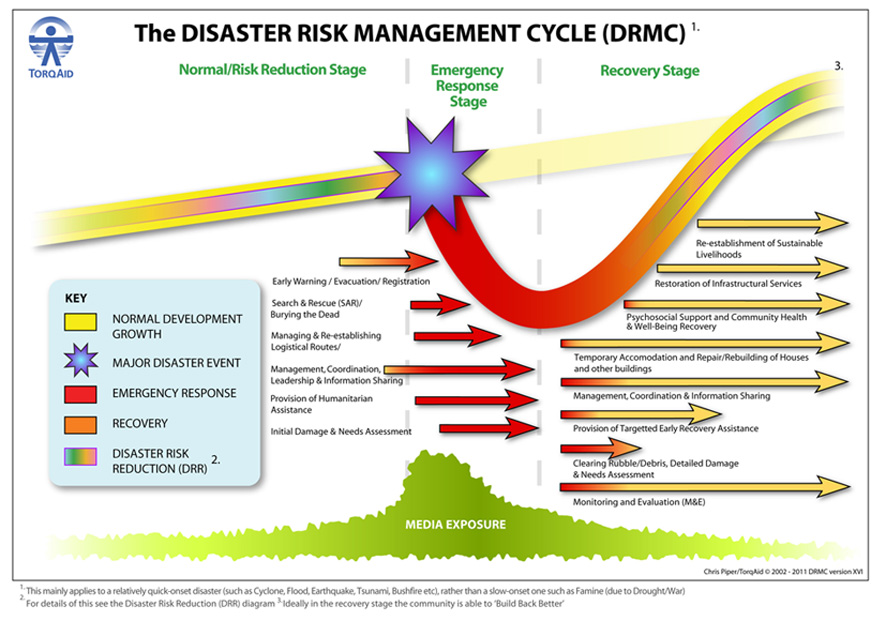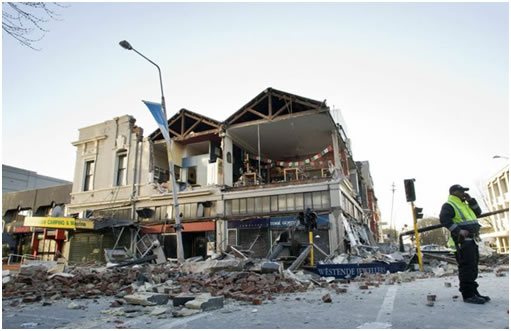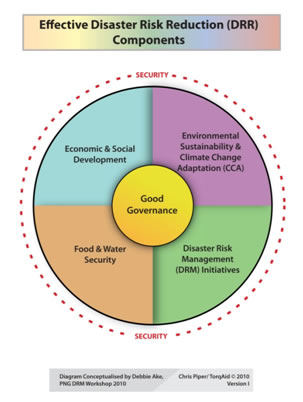Topic 3: The disaster cycle
The disaster cycle
The Disaster Risk Management Cycle (Figure 3.1) indicates that most medium to fast onset disasters pass through three separate stages, namely Normal/Risk Reduction, Emergency Response, and Recovery. The main initiatives which tend to occur in the Emergency Response and Recovery Stages are:
Emergency Response
- Early Warning/Evacuation/Registration
- Search and Rescue /Burying the Dead
- Managing and Re-establishing Logistical Routes
- Management, Leadership, Coordination and Information Sharing
- Provision of Humanitarian Assistance
- Initial Damage and Needs Assessment

Figure 3.1: The Disaster Risk Management Cycle (Click here to view larger readable image) Source: TorqAid website at http://www.torqaid.com, accessed November 2011 |

Christchurch in New Zealand, earthquake 2010
Source: http://www.foun.org.au/files/164701_164800/164779/christchurch-in-new-zealand-earthquake-2010.jpg
Recovery
- Management, Coordination and Information Sharing
- Clearing of Rubble/Debris. Detailed Damage and Needs Assessment
- Provision of Targeted Early Recovery Assistance
- Psychosocial Support and Community Health & Well-Being Recovery
- Temporary Accommodation and Repair/rebuilding of Houses and Other Buildings
- Restoration of Infrastructural Services
- Re-establishment of Sustainable livelihoods
- Disaster Risk Reduction (DRR)
- Development of an effective Monitoring and Evaluation system
Each of these Emergency Response and Recovery initiatives are challenging in themselves, and the larger the disaster, the more complex the Response and Recovery initiatives become.
There are a number of relevant and interesting publications which outline this complexity. For example Active Learning Network for Accountability and Performancein HumanitarianAction(ALNAP – www.alnap.org) has consolidated evaluations from the Indian Ocean Tsunami which summarise the challenges to stakeholders as they work through the Emergency Response and Recovery Stages, see the Optional Reading: A Ripple in Development to access this report.
 |
|
A ripple in development? Long term perspectives on the response to the Indian Ocean tsunami 2004 |
|
The role of the media
The role of the media in disasters is also clearly illustrated in the Disaster Risk Management Cycle (Figure 3.1). The majority of the media’s involvement occurs in the Emergency Response Stage, and there is a strong correlation between media exposure and funding. The challenge for practitioners is to manage these resources wisely, as inevitably the majority of financial support is required for a range of expensive initiatives in the later Recovery Stage. The recovery time framework should not be underestimated, as this process often takes years to complete. For example, following the Indian Ocean Tsunami in December 2004, the Indonesian-government initiated the Aceh and Nias Rehabilitation and Reconstruction Agency which operated over a four year period, from April 2005 through to May 2009.
The Disaster Risk Management Cycle illustrates that Disaster Risk Reduction initiatives are also important prerequisites for communities to allow themselves to ‘build back better’. This means that the range of recovery initiatives carried out in the Recovery Stage should result in communities re-establishing the socio-economic level they would have reached had there been no disaster and also equip them to be better prepared to face future potential disasters.
Disaster Risk Reduction (Figure 3.2) has five main complementary sectors, namely:
- Security & Good Governance
- Economic & Social Development, with a strong emphasis on Poverty Reduction
- Food and Water Security
- Environmental Sustainability and Climate Change Adaptation
- A range of Disaster Risk Management Initiatives
Figure 3.1 illustrates that if these complementary range of five Disaster Risk Reduction interventions are successful, then together they are able to minimise both the impact (and likelihood) of a potential disaster. Also, should a second disaster occur, the Disaster Risk Reduction initiatives undertaken should result in the host government, and communities themselves, transitioning more quickly out of the Emergency Response into the Recovery Stage.

Figure 3.2 The Effective Disaster Risk Reduction (DRR) diagram (Click here to view larger readable image) Source: TorqAid website at http://www.torqaid.com, accessed November 2011 |

Figure 3.3 Effective Disaster Risk Components
Source: TorqAid website at http://www.torqaid.com, accessed February 2011
Disaster Risk Reduction as illustrated in Figure 3.2 hypothesises that practitioners involved in this sector need to have a good understanding of the five key components of Disaster Risk Reduction, each of which are complex and sometimes contentious. An example of a recent contention is the current debate on Climate Change, and particularly the degree to which this is caused by mankind’s intervention, as compared to this just being a natural process.
Figure 3.3 illustrates that Good Governance is probably the key factor determining the effectiveness of all five.
 |
|
The following texts provide a useful background to the concept of Disaster Risk Reduction (Figure 3.2) in addition to a comprehensive overview of global food security issues:
|
|
For practitioners to work through the Normal/Risk Reduction, Emergency Response, and Recovery stages of a major disaster is challenging enough, even in a relatively advanced economy at peace with itself and its neighbours. When such scenarios strike poor developing countries, and/or those facing a degree of internal or external conflict, the situation becomes increasingly complex and problematic.
 |
|
||||||||
Look again at the event you chose for Activity 1.2 and research and summarise, in no more than 250 words for each country/event, the main initiatives which have taken place in the Response and Recovery stages of this event.
|
|||||||||